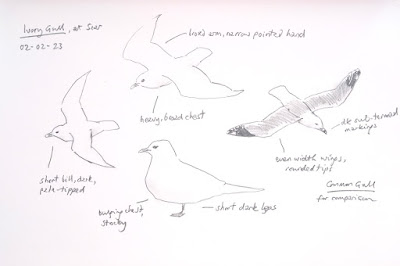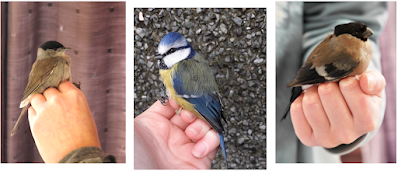This article and the images contained within were provided courtesy of the author, S. Grover.
Flock sizes of Pale-bellied Brent Geese about the Wig varied as much as the changeable weather that accompanied them. Even during the course of a single day the numbers of birds altered, suggesting an interchange of birds about Loch Ryan, or a continual passage of migrants. A flock of 308 birds grazed the ‘Twite Field’ at the Wig, on the 15th; this represented the highest single count of them during the month. Perhaps another indication of the Brent migration was the ten birds logged at Piltanton during a Wetlands Bird Survey count on the 19th - the species is something of a rarity at this site, at least if my monthly counts are anything to go on, so any found here are an unusual occurrence and are likely indicative of a movement of birds.
Pink-footed Geese were more often heard than seen, flying out to feed in the early hours of the morning and returning under the cover of darkness late in the night. I did manage to log over 400 birds lifting off from the Scar beach at dawn on the 22nd.
Shelducks remained Scarce all month at the Wig, with a maximum of three birds recorded on the 17th. Good numbers of Pintail are regularly seen on the Solway, such as at Caerlaveroc, but here on the Rhins of Galloway they are only ever few and sporadic in occurrence. Four at Loch Connell, on the 12th, were thus a welcome sight. Presumably they were the same birds still present here on the 26th: a gorgeous drake and another, younger, moulting male alongside two females. The same location hosted 198 Teal on the 5th. Numbers of Wigeon on my local patch were considerably down on last month.
Eiders are one of the most familiar sea ducks to birders acquainted with Loch Ryan. Their large size makes them more obvious than most, for sure; but when they are seen at any great distance that familiarity is all but lost and they appear as dark shapes. Then, they could be mistaken for scoters, mergansers, or some other species; only astute, patient observation and cognisance of jizz can confirm their presence. There were several such irresolute identification incidents this month! The opportune moment arrived on the 19th when I was successfully able to log 241 birds.
 |
| Waterfowl on Loch Ryan, including distant Eiders, Red-breasted Mergansers and Common Scoters |
Female and immature Goldeneyes are easily overlooked, especially when there are boldly marked drakes about to attract the viewer’s attention. The males have the habit of throwing back their heads and momentarily pointing their bills skywards when displaying - a performance they readily practice at this time of year. Although it is always my intent to count these birds, I all too easily become distracted by the ceremonies in which these birds engage. On the the 7th, however, I refrained from such diversion for long enough to tally 38 birds - only a small sample of those actually occupying Loch Ryan. It is equally easy for me to become absorbed by the activities of resplendent Long-tailed Ducks when I should be concentrating on the daily log. A flock of nine was the largest I registered, which included a male in nearly full breeding plumage - a very different dress from the typical winter attire. It is fortunate that this species can be readily observed at the Wig, unlike Scaup, which mostly reside at the southern end of Loch Ryan. During a brief stop at Bishop Burn, on the 19th, I registered 517 of the latter species. Curiously, a female Scaup was also present at the freshwater site of Loch Connell on the same day.
Common Scoters were observed daily on the sea-loch, with over 100 birds being registered on seven days, with a peak of 173 on the 18th. Velvet Scoters were noted on three days, with four on the 2nd, a male on the 4th, and a male and female on the 6th. These sightings, being close together, were probably the same birds. Loch Connell hosted a small number of Tufted Ducks, with seven being the highest count on the 12th. This site also held several Goosanders, with nine on the 19th. Red-breasted Mergansers were present throughout the month on Loch Ryan. They were mostly observed in small, highly mobile parties, which made it a tad tricky to ascertain their true numbers without the risk of double-counting. However, on the 7th, a confirmed tally of 66 was registered … with a further 38 probables, I might add!
Great Northern Divers are big birds: consequently they can be easier to spot a long way offshore. This probably accounts for them being logged on 16 days across the month, with a maximum of four birds on the 7th and the 16th. The smaller Red-throated Divers were considerably more abundant, with a peak of 63 on the 7th. In recent years Red-necked Grebes have become an expected sight about Wig Bay during the course of the winter, but this February they have been in short supply: a singleton on the 7th, and three on the 18th. It is likely that birds were present throughout the period but were occupying areas of Loch Ryan that were not visible from any of the stations I am able to observe from. Slavonian Grebes made up for the paucity of their cousins: 20 were noted on the 16th, including one bird in full summer plumage, sporting a brick-red neck and golden ear-tufts. Lovely!
Now is the time of year when small parties and larger flocks of Golden Plovers begin to pass through the area on their migration to their breeding grounds. The largest flock I encountered at the Scar was 44 birds, which isn’t big by any standards, but greater numbers will undoubtedly be recorded when the Spring passage gets properly underway. Grey Plovers, likewise, stop off here, though never in high numbers: three on both the 23rd and the 26th was my highest count. A single Lapwing at the Scar is summary enough of this species’ status on my local patch.
The trio of smaller waders - Dunlin, Turnstone and Ringed Plover - that frequent the shore-line of Wig Bay are easily missed whenever they hunker down amongst the pebbles, stones and seaweed. Only the latter species formed a flock worthy of mention, with 44 birds at the Scar on the 18th.
Numbers of Common Gulls appeared to be down on last month, with a flock of 275 being the largest I noted. The leucistic bird, mentioned in last months offering, turned up on the Wig Fields, on the 1st. It was a very white-looking bird indeed, which temporarily added to my confused state the following day, the 2nd, when a different white gull, the probable Ivory Gull (also referred to in the previous blog posting) reappeared at the Scar; I subsequently saw it there on the 5th and the 6th. I had just one record all month of Lesser Black-backed Gull: a solitary bird at the Scar on the 19th.
 |
| Some features of the probable Ivory Gull |
An immature, female Merlin was seen coming in off the sea and then hunting over the Wig Fields, on the 22nd. A single Little Egret was a pleasant addition to the otherwise common species that I logged at the Wig on the 20th. Shags continued to be present in reasonable numbers about the sea loch, with a flock of 88 being registered at the Scar on the 10th.
The mild conditions that prevail on the Rhins of Galloway (a consequence of the warm Gulf Stream ocean current) means that signs of the Spring season are witnessed earlier in the year than more inland locations. A Great Spotted Woodpecker heard drumming in Corsewall Estate woods, on the 26th, is one such example. Rooks have been seen attending their nests for a while now, but winter flocks are still commonplace: some 400 birds in a grassland near Kirminnoch (just west of Loch Connell), on the 12th, was a healthy congregation. Like the woodpecker mentioned above, other birds have also been venting song, including Skylark, Blackbird, Song Thrush, Robin, Dunnock and Chaffinch; these sounds became a daily presence during the latter days of the month.
Regular followers of this blog may recall the House Sparrow X Tree Sparrow in the previous two postings. Well, one such bird was again in my garden, on the 1st. This, however, was a different bird, with a wholly brown cap just like a genuine Tree Sparrow. Alas, no further sightings of any of these unusual hybrids were made thereafter.
Grey Wagtails are one of those species that are probably more common than the number of sightings of them would suggest. It is usually by a lucky accident that I encounter one. A very handsome and spritely bird enriched my day when I happened across it at St. Columba’s Well on the Corsewall Estate, on the 17th. The lemon-yellow in its plumage seemed to act like a spotlight marking its position and enabling me to track its progress amongst the otherwise drab tones of the surroundings in which it foraged. Rock Pipits are widespread along the shoreline of Loch Ryan during the winter. The diffuse brown tones of their plumage serve well to conceal them in the places they inhabit. A bird I saw at the Corsewall Burn outlet, on the 22nd, was subtly different however. It was much cleaner in appearance, with a whiter belly and greyish, not brown, tones topside. There is much variation within the tones displayed by this species; the general appearance of this bird suggested to me that it might be of the Scandinavian race, littoralis. Some of these regularly overwinter in Britain, especially on the east coast, but they only become apparent at this time of year when their summer plumage begins to show through.
 |
| Rock Pipit as seen at the Corsewall Burn outlet. |
In my summary log book I have always allocated space for each species I record; this follows a certain taxonomic order. That, however, has always proved problematical for some birds, in particular, the Linnet/Twite conundrum. With close views it is easy to separate these species but with more distant ones that identification becomes nigh impossible. As I become older, less active and less mobile, I find there is in increasing tendency for me to register such flocks in my notebook as Linnets/Twites, rather than making the distinction. And so to the dilemma - where to enter into the log such uncertainties - such as the 20 birds I saw on the 5th and the 18th of February? My preference, based upon past experience, would always err towards them being Twite … but we have to be accurate if the data generated is to be taken seriously; thus they are entered into my spreadsheet in the section reserved for such anomalies.







